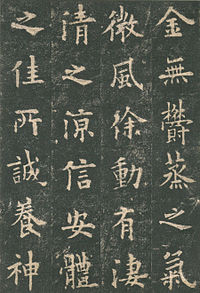The regular script[a] is the newest of the major Chinese script styles, emerging during the Three Kingdoms period c. 230 CE, and stylistically mature by the 7th century. It is the most common style used in modern text. In its traditional form it is the third-most common in publishing after the Ming and Gothic types used exclusively in print.[1]
| Regular script | |
|---|---|
 | |
| Script type | |
Time period | c. 2nd century – present |
| Related scripts | |
Parent systems | Oracle bone script
|
Child systems | |
| Unicode | |
| |
History
editThe Xuanhe Calligraphy Manual (
...clearly emerging from the womb of early period semi-cursive script. If one were to write the tidily written variety of early period semi-cursive script in a more dignified fashion and were to use consistently the pause technique [(
頓 ; dùn)], used to reinforce the beginning or ending of a stroke when ending horizontal strokes, a practice which already appears in early period semi-cursive script, and further were to make use of right-falling strokes with thick feet, the result would be a style of calligraphy like that in the "Xuān shì biǎo".
However, very few wrote in this script at the time other than a few literati; most continued writing in the neo-clerical script, or a hybrid form of semi-cursive and neo-clerical.[2] The regular script did not become dominant until the 5th century during the early Northern and Southern period (420–589); there was a variety of the regular script which emerged from neo-clerical as well as regular scripts[4] known as 'Wei regular' (
The script is considered to have become stylistically mature during the Tang dynasty (618–907), with the most famous and oft-imitated calligraphers of that period being the early Tang's Four Great Calligraphers (
During the Northern Song (960–1127), Emperor Huizong created an iconic style known as 'slender gold' (瘦金
92 rules governing the fundamental structure of regular script were established during the Qing dynasty (1644–1912); the calligrapher Huang Ziyuan wrote a guidebook illustrating these rules, with four characters provided as an example for each.
Characteristics
editThe Eight Principles of Yong encapsulate varieties of most strokes that appear in the regular script.[6] Regular script characters with dimensions larger than 5 cm (2 in) are usually classified as 'large' (
Notable works written in regular script include the Northern and Southern-era Records of Yao Boduo Sculpturing (姚伯
Derivative styles
edit- Fangsong typefaces are based on a printed style which developed during the Song dynasty (970–1279)
- The most common printed typeface styles, Ming and sans-serif, are based on Fangsong
- Japanese textbook typefaces (
教科書 体 ; kyōkashotai) are based on regular script, but modified so that they appear to be written with a pencil or pen. They also follow the jōyō kanji character forms. - The bopomofo semi-syllabograms are nearly always written using regular script strokes.
Computer typefaces
editGallery
edit-
Xuanshi Biao by Zhong Yao, written during the early transition from clerical script to regular script
-
Sheng Jiao Xu by Chu Suiliang,[b] an example of regular script
Notes
editReferences
editCitations
editSources
edit- Gao, James Zheng (2009), Historical Dictionary of Modern China (1800–1949), Lanham, MD: Scarecrow, ISBN 978-0-810-84930-3
- Li, Wendan (2009), Chinese Writing and Calligraphy, Honolulu: University of Hawai‘i Press, ISBN 978-0-8248-3364-0
- Qiu Xigui (裘锡
圭 ) (2000) [1988], Chinese Writing, translated by Mattos, Gilbert L.; Norman, Jerry, Berkeley: Society for the Study of Early China and The Institute of East Asian Studies, University of California, ISBN 978-1-55729-071-7
